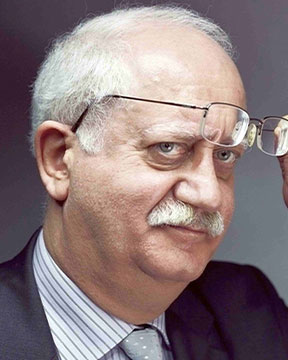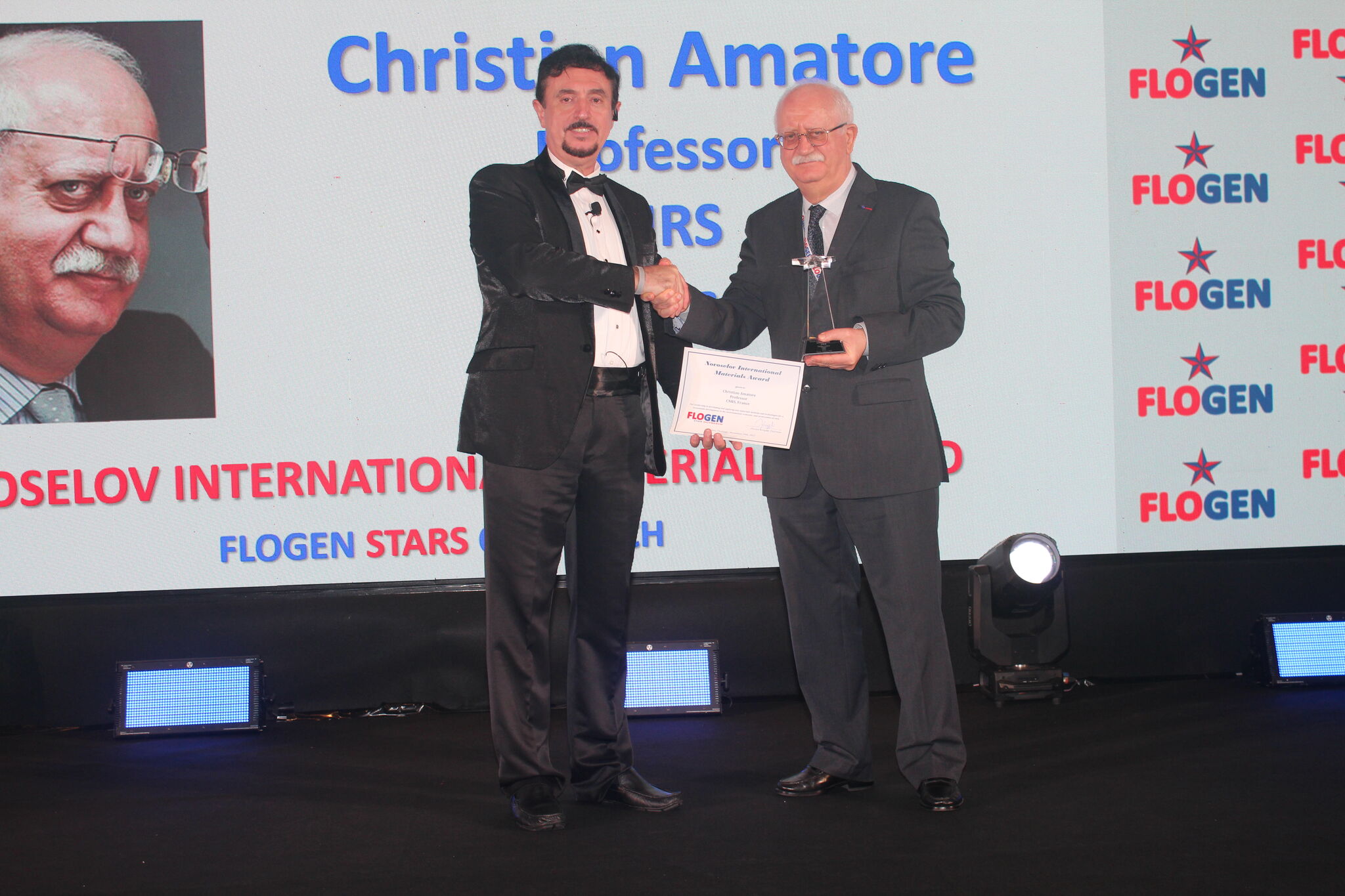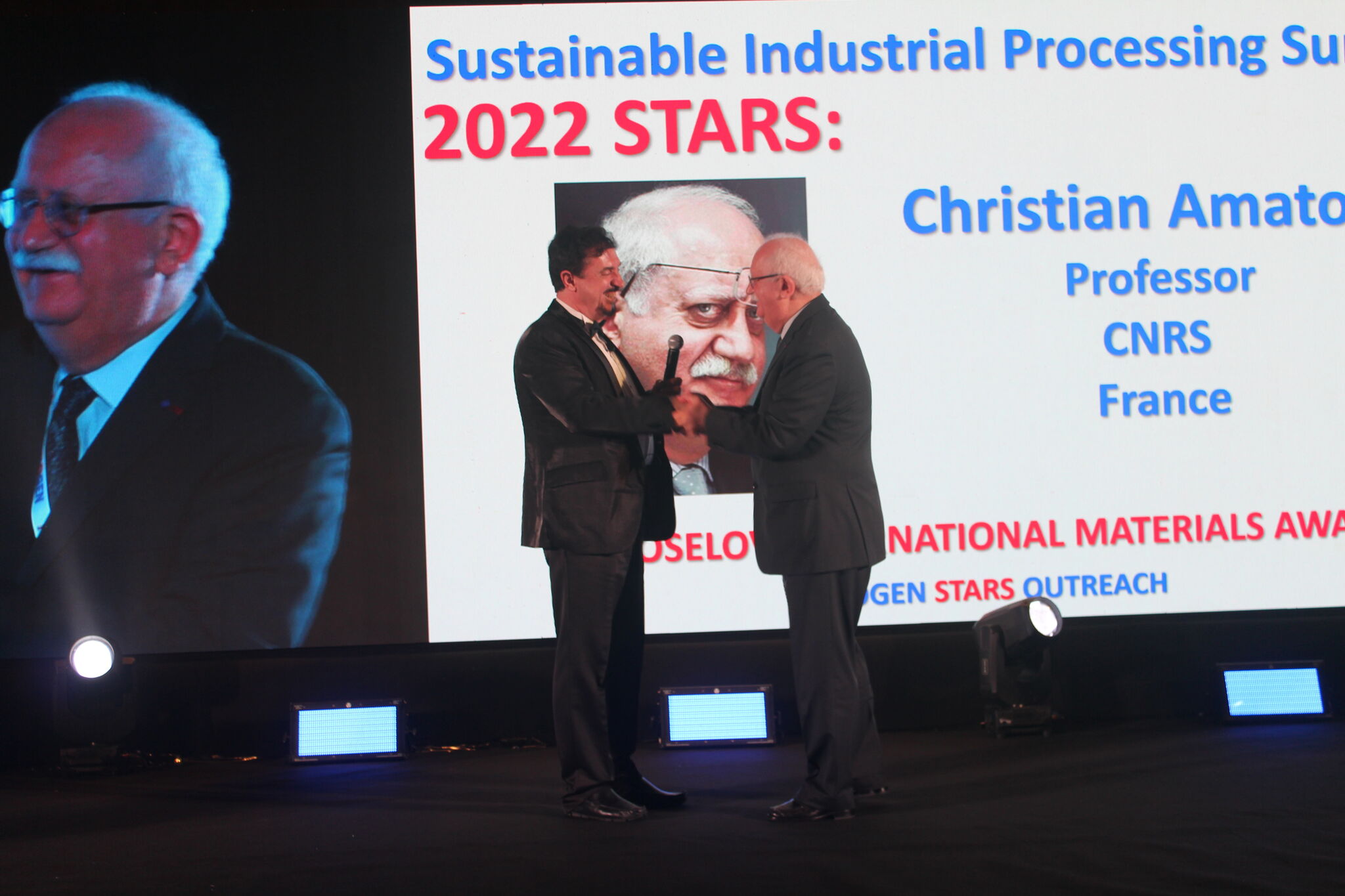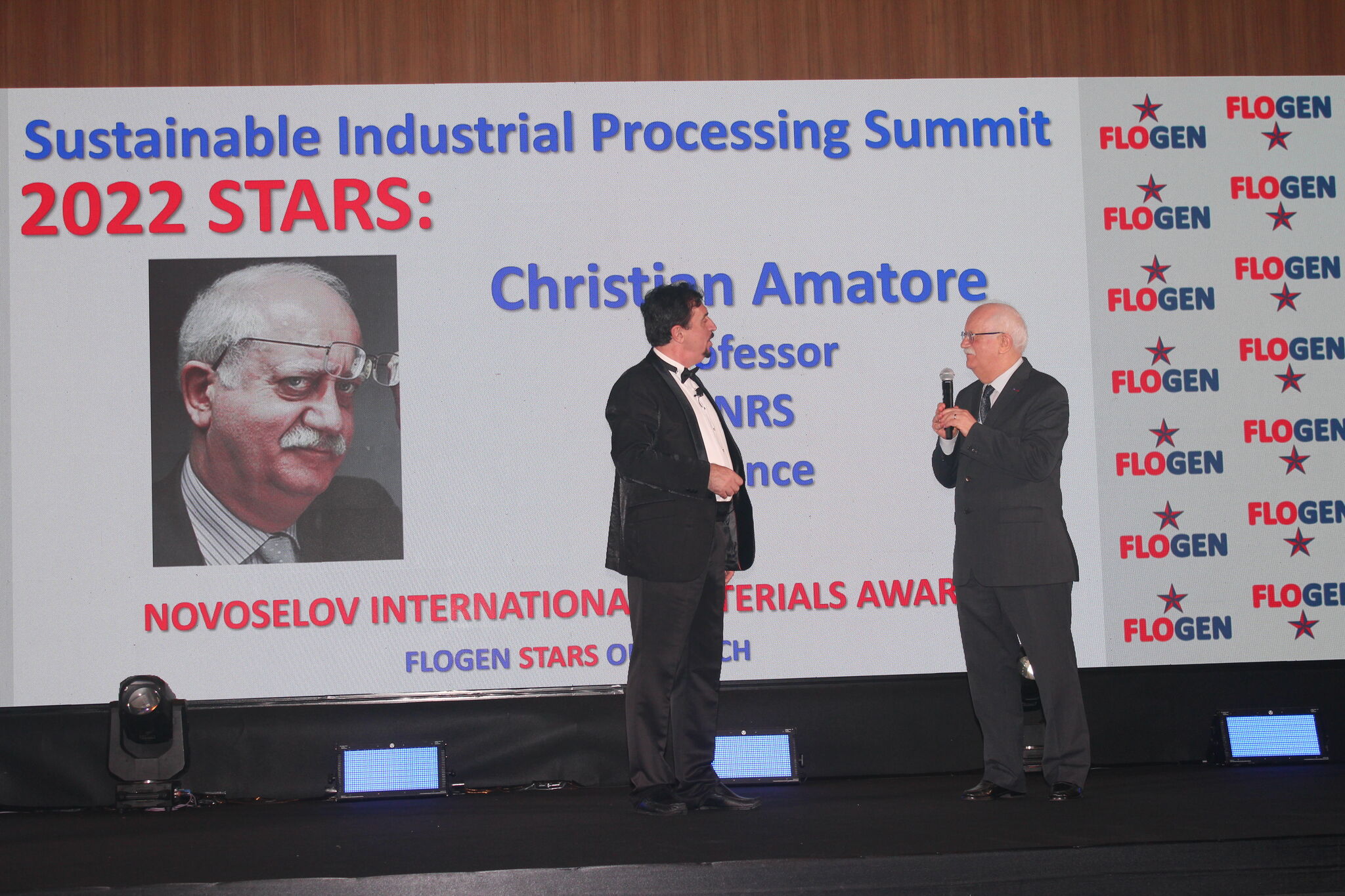
1) Brief biographical sketch
Professor Christian Amatore, was born in December 1951 from a recently immigrated modest family (Sicilian by his father, Swedish by his mother) and spent his childhood in Algeria in several garrison towns where his father was a non-commissioned officer of the Foreign Legion. His scientific and mathematical propensities were soon remarked by his school teachers who convinced his parents to encourage him to pursue his studies to middle and then high schools. His talents for the sciences continued to develop until he was accepted as an undergraduate student at the Ecole Normale Supérieure (ENS), being then one of the 11 best French students of the year for Physics and Chemistry. Since its creation, ENS is the most selective French centre for higher education and academic research. At 19, endowed with this important Sesame, he decided to continue his master's studies along all these fields and mathematics while selecting chemistry and chemical physics as his major curricula.
Following his Ph.D. and Habilitation (Doctorat d'Etat ès Sciences) obtained in 1979 from the University Paris Diderot under the guidance of Professor Jean-Michel Savéant, he was recruited by the Centre National de la Recherche Scientifique (CNRS) as a Research Associate Professor in Physical Chemistry. He then moved to Indiana University at Bloomington where he worked as a CNRS-NSF Assistant Professor with Professor Jay K. Kochi on single electron transfer (SET) activation of molecules and SET-catalysis in organometallic and organic chemistry. He returned to France in 1983 when offered a permanent CNRS-ENS Research Professor position at ENS to set up a fully innovative laboratory aimed to explore the possible connection between molecular electrochemistry and central mechanistic issues in organic and organometallic chemistry.
His seminal theoretical and experimental successful contributions in this original research direction quickly gained him recognition by the French and international communities. He was thus elected corresponding member of the French Academy of Sciences in 1996, being the youngest in all fields except for mathematics. In 2002, he was elected as Full Member of the French Academy of Sciences and became Chairman of its Chemical section in 2005. He then served during 4 years as a vice-President in charge of Education and Advanced Training and continues to serve now in its Committee for the Developing Countries (COPED).
The rest is history, as is fully documented in his Curriculum Vitae. At the age of 69, Christian Amatore remains fully active in research, being now Emeritus Professor in CNRS and ENS, Distinguished Professor of the University of Xiamen, Fujian, China, and still chairs the most recent of the two CNRS International Laboratories he has created at the instigation of CNRS.
2) Resume of Amatore's main research achievements
Even if, throughout his career, Christian Amatore felt obliged to devote a significant part of his efforts to creating and organizing Laboratories, creating one Doctoral School and a Federation, advising or animating many instance in the French Academy of Sciences as well in French or international scientific organizations, his most fundamental passion lies in scientific creative research, being entirely driven by the "pleasure of finding things out" to discover and stimulate new scientific avenues.
To this day, Christian Amatore is recognized around the world as one of the very few most prominent electrochemists of his generation but his reputation extends far beyond this field. His talent for designing and implementing imaginative approaches have led him to successfully open and explore many seemingly unrelated issues that cross over traditional borders between natural sciences. He did so by introducing innovative effective concepts that opened a series of creative approaches leading to radically new views. Amatore thus developed outstanding theoretical and instrumental concepts in electrochemistry which extended the traditional scopes and frontiers of his discipline leading to an impressive series of extremely important consequences in organic and organometallic catalysis or in cell biology, as is made clear in the following, and reaching as far as art and archaeology as evident by his world-renowned work on of "Horus' Oudjat", the antic Egyptian black make-up worn not only by Pharaohs but by the whole Egyptian population for its "magical" antibacterial properties.
His contributions, involving mechanistic studies of chemical and electron transfer catalysis, theoretical and experimental pioneering the developments of microelectrodes within a long partnership with R. Mark Wightman (now, Emeritus Professor at The University of North Carolina at Chapel Hill, USA) are legendary. In the hands of Amatore, electrochemical approaches could thus reach the nanosecond-timescale in voltammetry, nanometric diffusion layers, access to poorly conducting media, or could be specifically tailored to fit (bio)physicochemical investigations at the micro- and nano-scale level to detect and quantify small molecules of extreme importance for biological functions in single cells (vide infra). These achievements have seeded and stimulated numerous active researches areas in many excellent laboratories around the world and were recognized by his successive elections to several Academies of Sciences around the World and by prestigious Fellowships, awards and medals, as documented in detail in his Curriculum Vitae. For example, in 2010, he was elected Honorary Fellow of the Royal Society of Chemistry, an honour shared at the time only with a single other electrochemist and with three other French chemists, amongst them two Nobel Prize-winners.
New concepts supported by a series of elegant systematic mechanistic organometallic studies allowed him to firmly establish for the first time the detailed mechanisms of the extremely important nickel- (Kumada-Corriu) or palladium-catalysed (Stille, Negishi, Miyaura-Suzuki and Heck reactions) carbon-carbon couplings which belong to a class of pre-eminent reactions in the homogenous catalysis of key steps of fine-chemicals syntheses (Heck, Negishi, and Suzuki were awarded the 2010 Nobel Prize in Chemistry for "palladium-catalysed cross couplings in organic synthesis"). Amatore's works not only established the unifying mechanistic backbone of all of these reactions, but also explained why their high specificity and exquisite sensitivity are finely modulated by the nature of the exact precursors of catalytic palladium complexes and their preparation. His mechanisms, now disclosed in the advanced textbooks in the field, have offered simple experimental rules for understanding and optimizing most homogeneous palladium-catalysed reactions, e.g., by adding unexpected adjuvants such as chloride ions. This series of works led him to understand "What Makes a Good Catalytic Cycle?" and propose a general, although initially counter-intuitive, strategy to successfully optimize a wide variety of catalytic cycles.
Although he had well prepared himself through his excellent theoretical works on the electrochemical and physical properties ultramicroelectrodes — extended now to nanoelectrodes — one can't fail to be impressed by his careful studies about the quantitative kinetic analyses of secretion of small bioactive molecules from single living cells or tissues. He is achieving these spectacular feats mostly to apprehend the exact mechanisms of two important biological issues occurring at the cellular level. One concerns the fine coupling of soft matter with biological functions that drive kinetically the final stages of neurotransmitters release by endocrine cells or inside synaptic clefts of functional neuronal or neuromuscular junctions. The second is aimed to establishing the very nature of primary events giving rise to the formation of reactive oxygen and nitrogen species during oxidative stress conditions, for example, inside breast cells at different cancerous stages (normal, cancerous and metastatic) or inside macrophages phagolysosomes during phagocytosis. Through this convergent approach joining two distinct biological events, Christian Amatore could unambiguously characterize and quantify for the first time the molecular nature of the fine interactive coupling, commanded by nitric oxide emitted by active neurons to increase their blood supply by local capillaries vasodilatation in the brain. He thus solved a fundamental and essential brain mechanism postulated more than 180 years ago but which could never be established for lack of sufficiently local, sensitive and rapid analytical methods while it underpins today the monitoring of the brain activity by functional MRI. The talk he gave in 2013 at The Royal Society when he was invited to deliver the International Lecture of the Year was about this extraordinary feat. As soon as it may permeate through the cultural boundaries between scientific fields this research will undoubtedly impact several medical applications such as biochemical control of functional hyperaemia and especially of disorders that induce brain strokes or ischemia, but may also explain the initiation of Alzheimer disease. Indeed, Amatore's results demonstrate that in the presence of copper amyloid and ascorbic acid, the simultaneous existence of important locally coupled fluxes of oxygen and nitric oxide near active neurons irremediably supplies peroxynitrite, i.e., a molecular scissor prone to rapidly poke a series of pores through neurons' membranes. His work show indeed how strongly coupled are the phenomena of oxidative stress and neurotransmission at the very basic cellular level in the brain. Amatore is now on the way to transfer this knowledge and his imaginative cleverness within the framework of a small company to adapt his methods and concepts in order to detect fluctuations of hydrogen peroxide, nitrite ions and nitric oxide in the sweat of cardiovascular patients by a non-invasive microfluidic electrochemical patch.
To date, Amatore's research has resulted in the publication of 509 primary research articles in international journals with peer-review, several book chapters, 10 French Habilitation theses, 59 Ph.D. defended in France and 7 in foreign countries, 8 patents and more than 300 distinguished, award-winning, named, opening and plenary conferences. His works have been cited ca. 52.8 times each on average, with a total of 26,870 citations, an h-index of 84, an i10-index of 427 and a citation rate greater than approx. 1,250 citations per year over the past eight years according to the Clarivate-ISI Web of Science database. The Scopus database reports essentially similar statistical analyses. Google Scholar which also includes books, proceedings and doctorates or master's thesis manuscripts, etc., in addition to peer-reviewed scientific journals, reports that on the same date his works were cited ca. 70.2 times each on average, with more than 35,700 citations, an h-index of 94, an i10-index of 444 and a citation rate greater than ca. 1,850 citations per year over the past eight years, thus emphasizing the great importance of his researches for young scientists still in their scientific development, which gives him a particular joy because one of the achievements that has counted him the most besides "finding things out" is his teaching and supervision of students.
Nonetheless, It is a pity that these impressive researches that span from the organometallic and organic chemical catalysis to two key cellular mechanisms that could be imagined and achieved thanks to Amatore's masterful invention of new conceptual and experimental electrochemical approaches could not find their way to the top international journals of chemistry and physical chemistry being blocked by cultural boundaries that enshrine the most famous journals. Comically, his work on the antic Egyptian make-up was later publicized by these high-class journals and reported by thousands newspapers aimed to the public all around the world although it was rejected without review by these very same journals when submitted.
3) Organizing and collective inputs for research
Beyond his recognized talent and successes in pure research, Amatore has demonstrated his profound investment for creating and organizing scientific structures which contribute today through many facets to the visibility of France in electrochemistry as well as in modern avenues in physical, analytical and molecular chemistry for catalysis and cellular biology.
Since his nomination at ENS as a CNRS Research Professor at the exceptional age of 33, he started building up a research team which, within a few years, established itself as one of the most visible centres worldwide for molecular electrochemistry. Thanks to his ecumenical views rooted on a rare extended scientific knowledge, his recognized scientific talent and his charisma, he was asked by the ENS, the CNRS and the French Ministry of Research to accept the former prestigious Louis Pasteur's position at the ENS. He could then attract there major research teams but also young promising researchers whom he helped creating and organizing altogether a research centre integrating several chemical fields from theoretical physical and analytical chemistry to bio-organic chemistry with a particular emphasis on chemical issues of importance in many functions of life. Under Amatore's guidance and continuous efforts, this multidisciplinary laboratory gave back to the Department of Chemistry of ENS its exceptional visibility, and could contribute to the foundation of one of the most successful French doctoral school and a major French research federation in chemistry. Both have contributed to a complete revival of physical and analytical chemistry in Central Paris by helping to coordinate their objectives and research efforts towards major modern issues. This recognized scientific centre provides a crucial input in our modern understanding of molecular reactivity at the nano and micro dimensions which govern green chemistry and cellular biology. Based on these successes CNRS asked him to create a second international laboratory of CNRS in China, "NanoBioCatEchem", linking CNRS, ENS, Rennes, Xiamen and Wuhan universities.
Today, considering that his role in leading this scientific re-foundation of physical and analytical chemistry in Central Paris was accomplished, Amatore spontaneously preferred to ask younger scientists to pursue this task with their own inspiration so as to focus his own efforts onto on other issues that he believes are equally important for the continuation of science in future. This involved for example the training of young pupils, in particular by helping primary school and college teachers to develop scientific content likely to interest, promote and attract pupils, especially young girls, to science or to help the often difficult transition from high school to university first degree courses for talented but not sufficiently well prepared students. Before he became Emeritus, his last but not least involvement concerned his membership within the High Council of Science and Technology; there, with his nineteen distinguished colleagues, he advised the French governments on scientific issues for the benefice of France and its science. In the same vein, let us mention that he has just accepted an appointment by UNESCO as a member of the Scientific Board of its International Basic Sciences Program.
Full bio: https://www.flogen.org/sips2021/pdf/Christian_Amatore_Cv.pdf

Prof. Christian Andre Amatore, Receiving the Fray International Award from Dr. Florian Kongoli at FLOGEN SIPS 2022

Dr. Florian Kongoli congratulating Prof. Christian Andre Amatore on his award at FLOGEN SIPS 2022

Prof. Christian Andre Amatore, Delivering his acceptance speech to Dr. Florian Kongoli during the FLOGEN SIPS 2022 ceremony
FLOGEN SIPS 2022 Awards: Dr. Christian Andre Amatore, Professor, CNRS & French Academy of Sciences